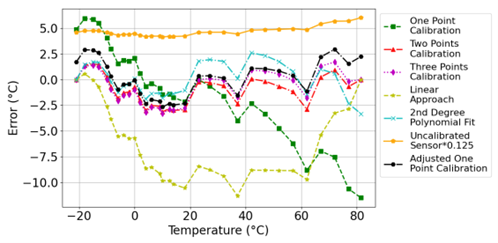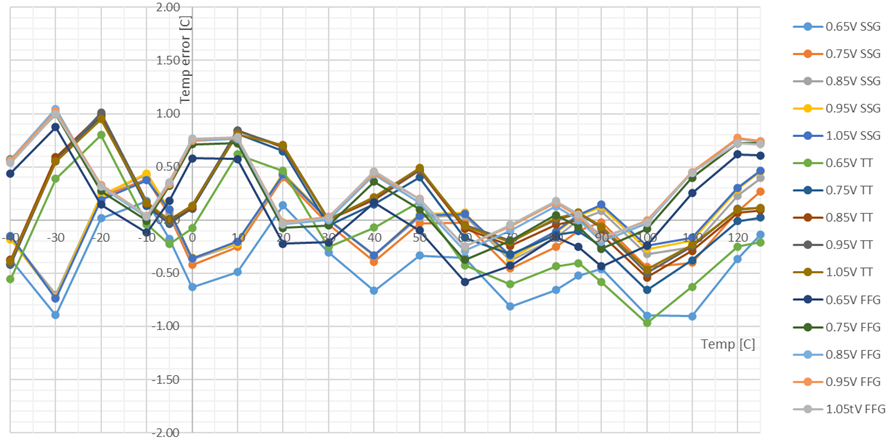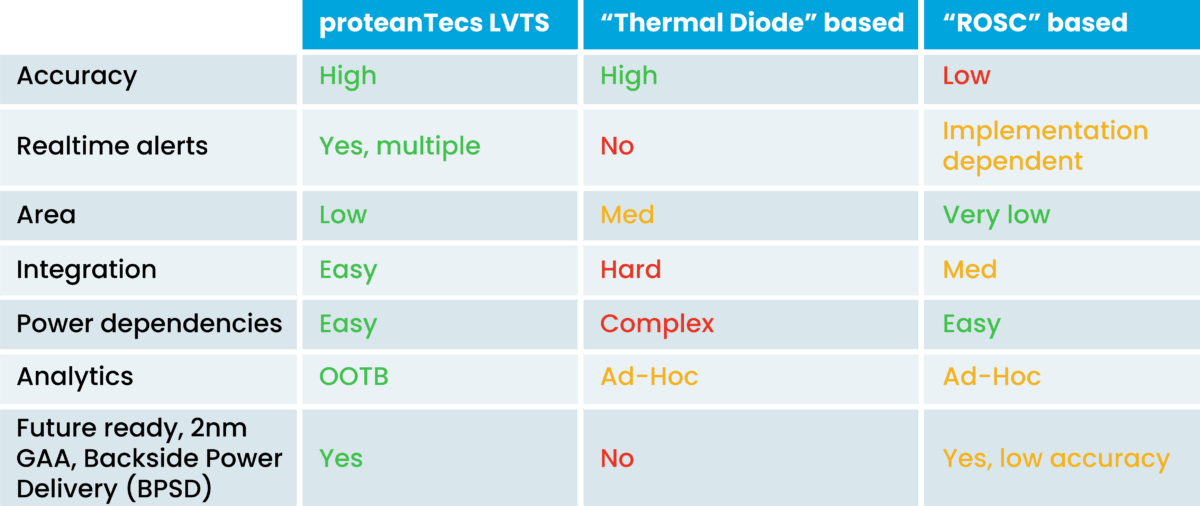By Nir Sever, Senior Director Business Development, proteanTecs
Silicon-proven LVTS for 2nm: a new era of accuracy and integration in thermal monitoring
Effective thermal management is crucial to prevent overheating and optimize performance in modern SoCs. Inadequate temperature control due to inaccurate thermal sensing compromises power management, reliability, processing speed, and lifespan, leading to issues like electromigration, and hot carrier injection and even thermal runaway.
Unfortunately, precise thermal monitoring reached an inflection point at 2nm, with traditional solutions proving less practical below 3nm. To tackle the issue, this article delves into a novel approach, accurate to ±1.0°C, that overcomes this critical challenge.
proteanTecs now offers a customer-ready, silicon-proven solution for 5nm, 3nm and 2nm nodes. In fact, our latest silicon reports demonstrate robust performance, validating that accurate and scalable thermal sensing is achievable in the most advanced nodes.
Accurate Thermal Sensing in Advanced Process Nodes: A Growing Challenge
As process nodes scale to 2nm and below, accurately measuring on-chip temperature has become increasingly difficult. Traditional Voltage and Temperature sensors based on diodes are less practical in these nodes due to their high-voltage requirements. This gap in temperature measurement creates risks that compel chipmakers to seek future-ready solutions. The challenge is magnified in designs that leverage DVFS techniques.
Why Traditional Solutions Fall Short
Traditional thermal sensing technologies are hitting hard limitations in precision and overall feasibility when moving beyond 3nm:
- Temperature sensors based on BJT diodes
Analog thermal diodes with Bipolar Junction Transistors (BJTs) have been a go-to option for accurate thermal sensing. However, their reliance on high I/O voltages makes them inapplicable for nodes beyond 3nm based on Gate-All-Around (GAA) technology, which doesn’t support high I/O (analog) voltages, and BJT support may be discontinued as well in the future.

PNPBJT in a diode-connected configuration. The base-emitter junction has a predictable transfer function that depends on temperature, making it suitable for thermal sensing. However, analog thermal diodes are a no-go for nodes beyond 3nm.
Even before GAA, thermal diodes suffered from low coverage as they were hard to integrate. Their design restricted placement to chip edges near the I/O power supply, leaving vital internal areas unmonitored due to analog routing limitations. Furthermore, they consumed more power than low-voltage alternatives due to their high-voltage requirement.
- Digital Temperature Measurements based on Ring oscillators
Ring oscillators are scalable to advanced nodes, but their temperature measurement error can be as high as ±10°C. They are inadequate where accuracy is paramount. One example concern using thermal sensing to determine voltage or frequency adjustments (e.g. DVFS), as even slight temperature variations can significantly degrade performance.

A Thermal Sensor Built for the Future
proteanTecs LVTS™ (Local Voltage and Thermal Sensor) is purpose-built for precision thermal sensing in advanced nodes without relying on I/O transistors and high analog I/O voltages and even BJTs. It measures temperature with accuracy of ±1.0°C while using core transistors exclusively and operating in a wide range of core voltages, combining precision with future readiness for GAA nodes.
Key features of LVTS:
- Temperature measurement accuracy of +/-1°C (3-sigma)
- Voltage measurement accuracy of +/-1.5% (3-sigma)
- Over temperature fast alert
- Wide range of operational voltages (650-950 mV)
- High-speed measurement

Unmatched Benefits Across All Critical Parameters
LVTS operates with low VDD core rather than high I/O voltage while maintaining superb accuracy, unlike Digital Thermal sensors based on ring oscillators. This unique design enables easy integration anywhere on the chip, providing more granular voltage and temperature monitoring than thermal diodes. Additionally, its smaller size and lower power consumption minimize the impact on PPA compared to BJT-based solutions.

An additional capability of LVTS provides real-time warnings and critical alerts in the form of HW signals when predetermined thermal thresholds are breached. This feature enables immediate corrective action, reducing the risk of overheating to maintain chip integrity.
LVTS Flavors for Enhanced Flexibility
In addition to the standard LVTS described above, proteanTecs offers two specialized variants to address diverse design needs:
- An extended flavor – includes external voltage measurement to extend the measured voltage range down to zero volts.
- A distributed flavor – designed as a Core VDD-only, analog thermal and DC voltage level sensor hub, it supports extremely small remote thermal sensors for precise temperature measurements at hot spots.
These two versions complement the regular LVTS, allowing chipmakers to tailor their thermal sensing approach for maximum coverage, precision, and responsiveness in critical areas of the design.
Complementing Deep Data Analytics with Accurate Voltage and Temperature Sensing
LVTS is already silicon-proven in 5nm, 3nm, and now also in 2nm, with a detailed silicon report available, making it the industry-leading, future-proof, customer-ready solution.
This innovation was warmly embraced by multiple chipmakers concerned about the absence of accurate and reliable thermal sensing in next-generation silicon.
These customers use LVTS alongside other proteanTecs products, as it complements the broader deep data monitoring and analytics solutions explored here.
LVTS is seamlessly integrated into proteanTecs’ HW Monitoring System, enabling accurate DC voltage and thermal measurements real-time, making LVTS a vital addition to chipmaker power and reliability strategies.
Want to know more about how LVTS can help scale your design to advanced nodes with accurate voltage and temperature sensing? Contact us here.
[1] El-Zarif, Nader, Mostafa Amer, Mohamed Ali, Ahmad Hassan, Aziz Oukaira, Christian Jesus B. Fayomi, and Yvon Savaria. 2024. “Calibration of Ring Oscillator-Based Integrated Temperature Sensors for Power Management Systems” Sensors 24, no. 2: 440.
Nir Sever brings with him more than 30 years of technological and managerial experience in advanced VLSI engineering. Prior to joining ProteanTecs, Nir served for 10 years as the COO of Tehuti Networks, a pioneer in the area of high speed networking Semiconductors. Before that, he served for 9 years as Senior Director of VLSI Design and Technologies for Zoran Corporation, a recognized world leader in Semiconductors for the highly competitive Consumer Electronics Market. Nir was responsible for driving Zoran silicon technologies and delivering more than 10 new silicon products each year. Prior to Zoran, Nir held various managerial and technological VLSI roles at 3dfx Interactive, GigaPixel Corporation, Cadence Design Systems, ASP Solutions and Zoran Microelectronics. Nir earned his BSEE degree from the Technion – Israel Institute of Technology.
Also Read:
DAC News – proteanTecs Unlocks AI Hardware Growth with Runtime Monitoring
Webinar – Power is the New Performance: Scaling Power & Performance for Next Generation SoCs
Podcast EP279: Guy Gozlan on how proteanTecs is Revolutionizing Real-Time ML Testing
Share this post via:






Comments
There are no comments yet.
You must register or log in to view/post comments.